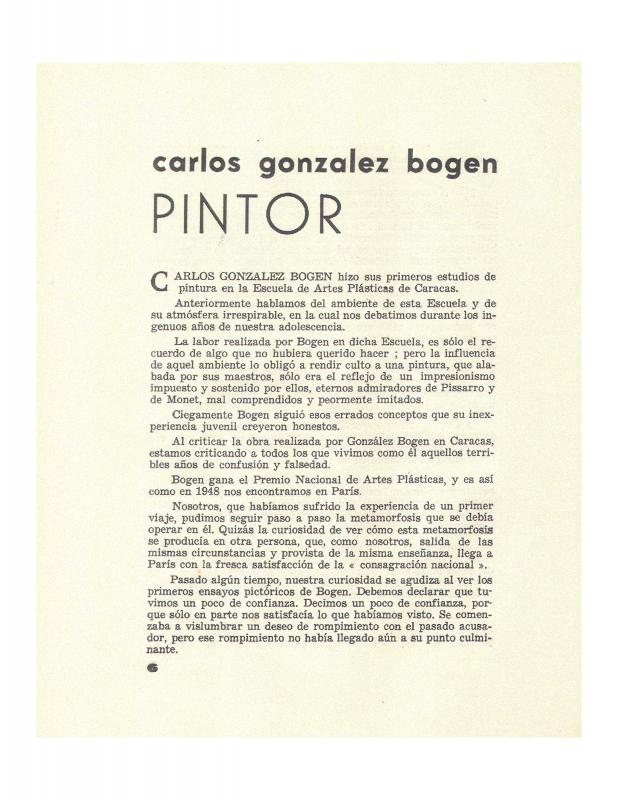Los Disidentes was a group started in Paris in 1950 by a number of Venezuelan artists and writers who lived there from 1945 to 1952. From their home base in Paris they decided to challenge the official education provided by the Escuela de Artes Plásticas de Caracas, which was based specifically on landscape painting and nativist art. In the spirit of their name, Los Disidentes sought to breathe new life into traditional and academic art through an assimilation of the values espoused by European abstraction. The painters in the group included the author of this essay, Alejandro Otero (see also “Del arte abstracto” [doc. no. 813611], “Poetas: Críticos de arte” [doc. no. 813445], “Gastón Diehl promulga y espera una resurrección del espíritu impresionista en Venezuela?” [doc. no. 813625] and “Mateo Manaure en la pintura: Un joven pintor venezolano, en viaje hacia París” [doc. no. 813639]), Pascual Navarro, Luis Guevara Moreno, Carlos González Bogen (“La escuela ‘de los paisajistas’ de Caracas” [doc. no. 813695] and “‘De nuevo’ Los Disidentes” [doc. no. 813667]), Mateo Manaure (“Carlos González Bogen: Pintor” [doc. no. 813583]), Narciso Debourg (“En torno a la pintura de hoy” [doc. no. 813597]), Perán Erminy (“Alrededor de la historia de ‘Los Disidentes’” [doc. no. 813463]), Rubén Núñez, Dora Hersen, and Aimée Battistini, as well as J. R. Guillent Pérez, who was a philosophy student at the time (“Lo latinoamericano y lo occidental [Parte I]” [doc. no. 813723] and “Lo latinoamericano y lo occidental: (Continuación)” [doc. no. 813478]). They were later joined by other Venezuelan artists such as Armando Barrios, Miguel Arroyo, Oswaldo Vigas, Omar Carreño, Alirio Oramas, and Régulo Pérez. They published a magazine, named after the group, Los Disidentes, which carried all their news, and appeared a total of five times.
In this article, the painter Alejandro Otero (1921–90) takes a close look at every level of contemporary Venezuelan cultural society from the perspective of a revolutionary artist. He identifies each segment’s vices, neither skimping on epithets nor making concessions. He therefore presents a view of Venezuela as a “stuffed” society in which the power structure resists change and everyone else acquiesces. The ideas expressed in this article echo those espoused by the Los Disidentes group and the principles that Otero would defend throughout his life and working career. It is strange, however, that he did not acknowledge a single Venezuelan public institution, in view of the fact that he had received a grant from an official organization to study in Paris. And, furthermore, considering that, barely a year before he wrote this article, Otero had exhibited his series Las Cafeteras at the Museo de Bellas Artes in Caracas (a prestigious official institution), in what was actually the first exhibition of Abstract art by a Venezuelan painter. The answer to these questions may well be found in a letter that Otero wrote to the Venezuelan historian Alfredo Boulton (April 8, 1950) [doc. no. 850293], in which he defends his position and states that, even at the risk of forfeiting his grant, he stands by his contention that young Venezuelan artists are indeed taking the path of least resistance by not breaking with established traditions. In so doing, he reaffirms his commitment to Los Disidentes.












